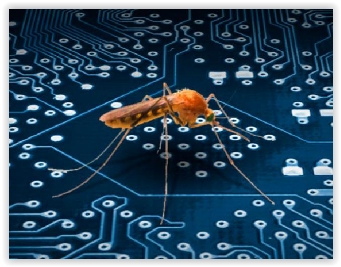 Latent short circuit failures have been observed during testing of PCBs for power distribution of spacecraft of the European Space Agency. Root cause analysis indicates that foreign fibers may have contaminated the PCB laminate. These fibers can provide a pathway for electromigration if they bridge the clearance between nets of different potential in the presence of humidity attracted by the hygroscopic laminate resin. PCB manufacturers report poor yield caused by contamination embedded in laminate. Inspections show that fiber contamination is present on prepreg and etched innerlayers. Further fiber contamination may be attracted in the manufacturing environment due to static charging. The requirements for cleanliness that are specified for final PCBs are orders of magnitude more stringent than
Latent short circuit failures have been observed during testing of PCBs for power distribution of spacecraft of the European Space Agency. Root cause analysis indicates that foreign fibers may have contaminated the PCB laminate. These fibers can provide a pathway for electromigration if they bridge the clearance between nets of different potential in the presence of humidity attracted by the hygroscopic laminate resin. PCB manufacturers report poor yield caused by contamination embedded in laminate. Inspections show that fiber contamination is present on prepreg and etched innerlayers. Further fiber contamination may be attracted in the manufacturing environment due to static charging. The requirements for cleanliness that are specified for final PCBs are orders of magnitude more stringent than
those specified for base materials. This paper describes inspections performed on base materials, manufacturing processes and final PCBs. It describes test methods that detect reduced insulation caused by contamination and electromigration. Moreover, a proposal is presented specifying tightened requirements for a new class of base materials for the manufacture of high-reliability PCBs.
I. Introduction
Latent short circuit failures have been observed in PCBs during testing of power distribution units of spacecraft for the European Space Agency (ESA). Root cause analysis has been conducted under review of non-conformance review boards (NRB). Printed circuit board assemblies failed after prolonged functional testing in ambient laboratory environment or after thermal vacuum cycles. Due to the large amount of damage caused by the electrical overstress, it was not possible to obtain direct evidence of the failure. However, a working hypothesis has been developed indicating that fiber contamination may have caused a latent short circuit. This hypothesis was further substantiated by reports on contamination issues in base materials and by a test method that demonstrated the breach of insulation due to fiber contamination.
At the time of the observed failures at equipment level, PCB manufacturers reported poor cleanliness levels of base laminate materials, causing poor yield. It is not possible to screen in an efficient manner for contamination in copper-clad laminate, since visual inspection requires stripping of the copper. Several inspection methods show the lack of cleanliness of base materials, which is specified in IPC4101
